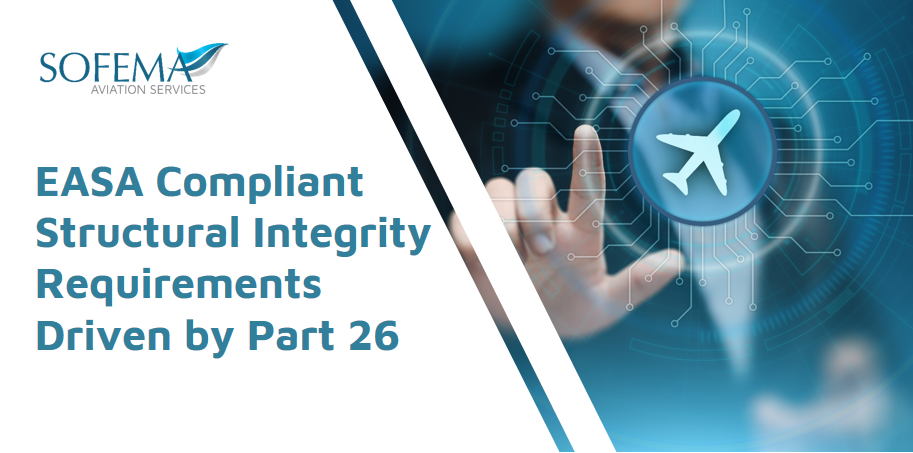EASA Compliant Structural Integrity Requirements Driven by Part 26 – Further Considerations by Sofema Online (SOL) www.sofemaonline.com
Introduction
This regulation has been updated to address the possibility of catastrophic failure of large ageing aeroplanes due to fatigue and corrosion.
Attention is given to the following key areas:
- Fatigue of the basic type design
- Widespread fatigue damage
- Corrosion
- Adverse effects of changes and repairs
- Continued operation with unsafe levels of fatigue cracking
Required Actions
- The TCH is required to perform a Fatigue and Damage Tolerance Evaluation (DTE) and include the results in the Airworthiness Limitations Section (ALS) of the MPD or in a Supplemental Structural Inspection Programme.
Note – The operator shall include these inspections in the AMP.
Overview related to existing practices
- Concerning existing damage tolerance evaluation and inspections, early fatigue requirements, such as ‘fail safe’ regulations did not provide for timely inspection of an aircraft’s critical structure to ensure that damaged or failed components could be dependably identified and then repaired or replaced before hazardous conditions developed.
- Aeroplanes certificated to fatigue requirements pre JAR 25 Change 7 FAR Amdt
25 45 did not address damage tolerance and still operate in Europe Many (April 1981)
- ·TCHs have developed supplemental inspection programmes (based on damage tolerance for these older aeroplanes, but this is not the case for all large aeroplanes)
Addressing the Potential for Widespread Fatigue
- Certain TCHs are required to establish a Limit of Validity (LoV) of the Structural Maintenance Programme and establish maintenance actions based on a WFD evaluation of the type design.
- The operator must include the LOV in the AMP and subsequently implement the maintenance actions.
Overview and Comments related to Limit of Validity (LoV) and Widespread Fatigue (WFD) evaluation
It was generally assumed when fatigue and fail-safe rules were first implemented that any cracking that occurs on an aircraft operated up to the DSG will occur in isolation, originating from a single source, such as a random manufacturing flaw or a local design detail. However, WFD in a structure is characterized by the simultaneous presence of cracks at multiple structural details that are of sufficient size and density whereby the structure will no longer meet the applicable residual strength requirements.
Fatigue and Damage Tolerance Requirements
F&DT requirements (JAR 25 571 Change 7 and CFR 14 § 25 571 Amdt 45 onward) and associated inspections were intended by Authorities to find and correct all forms of fatigue damage before they become critical and a similar approach to F&DT was used as a basis for the Supplemental Structural Inspection. Document (SSID).
It has become apparent that as aircraft have approached and exceeded their DSG, not all maintenance programmes have adequately addressed WFD and subsequent voluntary action by some TCHs to address WFD did not result in a uniform application of state of the art WFD prevention principles described in AMC 20 20 and the risk presented by WFD remains.
Corrosion Prevention and Control Program
The TCH is required to develop a baseline corrosion prevention and control programme.
The operator incorporates a CPCP in the AMP taking into account the baseline CPCP.
Existing large aeroplane structures are vulnerable to corrosion and most, but not all are subject to a CPCP.
Note: A CPCP is a systematic approach to prevent and to control corrosion in the aircraft’s structure. The objective of a CPCP is to limit the deterioration due to corrosion to a level necessary to maintain airworthiness (typically Level 1 corrosion or better) and where necessary to restore the corrosion protection schemes for the structure.
An effective CPCP not only limits the direct effects of corrosion but helps prevent fatigue failures initiated by corrosion and the detrimental effects of fatigue and corrosion in combination.
Structural Fatigue Failures – Related to Changes & Repairs
- Fatigue and damage tolerance evaluations (DTE) and associated damage tolerance based inspections (DTI) are required for existing repairs and changes.
- This requires a coordinated effort between the design approval holders and the operators upon whose aircraft the repairs or changes are implemented, to ensure the continued structural integrity of all relevant modified and repaired structures, based on damage tolerance principles, consistent with the safety level provided by the SSID or ALS as applied to the baseline structure.
Next Steps
Follow this link to our Library to find & Download related documents for Free.
Sofema Aviation Services www.sassofia.com & Sofema Online www.sofemaonline.com provide EASA regulatory compliant and vocational training including CAMO, AMC20-20 and Part 26 / CS 26 Please see the websites or email team@sassofia.com
Tags:
Aircraft, AMP, aviation, Airworthiness, Regulations, Aging Aircraft, EASA Part 26, Fatigue damage, Corrosion, Widespread Fatigue





